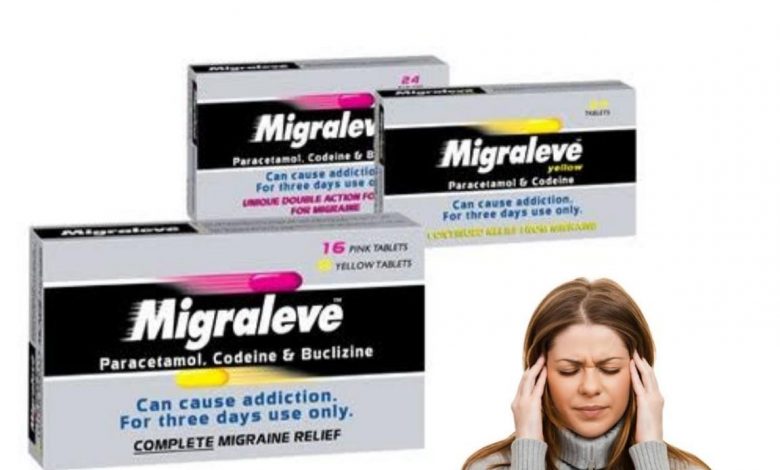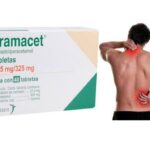Migraleve: Ingredients, Uses, Benefits, Side Effects, Addiction

Migraleve is a combination analgesic medication principally containing Paracetamol (acetaminophen), and codeine. Migraleve is used for the treatment of migraine attacks, including the symptoms of migraine.
Migraine is a headache that can cause severe throbbing pain or a pulsing sensation, usually on one side of the head. It’s often accompanied by nausea, vomiting, and extreme sensitivity to light and sound.
There are two variants of Migraleve: Yellow and pink, which both contain the analgesics Paracetamol and codeine. The yellow variant is designed to address the symptoms of headache and discomfort, whilst the pink variant also addresses symptoms of nausea and vomiting. A third Migraleve variant, Migraleve Ultra, contains sumatriptan.
Migraleve Pink
The active ingredients of Migraleve pink are:
- Paracetamol 500 mg,
- Buclizine hydrochloride 6.25 mg
- Codeine phosphate 8 mg
Migraleve Yellow
The active ingredients of Migraleve yellow are:
- Paracetamol 500 mg
- Codeine phosphate 8 mg,
Migraleve Ultra
The active ingredient of Migraleve Ultra is 50 mg sumatriptan, similar to Imigran recovery.
What does each tablet of Migraleve do?
Migraleve Pink tablets: contains paracetamol and codeine which ease pain and buclizine which helps relieve nausea and vomiting. The Pink tablets, therefore, treat all the symptoms of migraine. If taken at the first sign of a migraine, Migraleve Pink tablets can prevent an attack from developing.
Migraleve Yellow tablets: contains Paracetamol and codeine for the treatment of pain and relief of continuing migraine symptoms. They should always be taken after the first dose of Migraleve Pink tablets.
Migraleve can be used in children over 12 years of age for the short-term relief of moderate pain not relieved by other pain killers such as paracetamol or ibuprofen alone.
Migraleve contains codeine. Codeine belongs to a group of medicines called opioid analgesics which act to relieve pain.
Before you take Migraleve
This medicine is suitable for most people but a few people should not use it. If you are in any doubt, talk to your doctor or pharmacist.
Do not use this medicine:
■ Unless your migraines have been diagnosed by a doctor.
■ If you are allergic to paracetamol, codeine or buclizine, or any of the other ingredients of this medicine (listed in section 6).
■ If you are taking other medicines containing paracetamol.
■ In children under 12 years of age.
■ For pain relief in children and adolescents (0-18 years of age) after removal of their tonsils or adenoids for obstructive sleep apnea syndrome.
■ If you know that you metabolize codeine into morphine very rapidly.
■ If you are breastfeeding.
If any of these apply to you, get advice from a doctor or pharmacist without using Migraleve.
Take special care…
■ If you suffer from liver or kidney disease.
■ If you have Gilbert’s syndrome (familial non-hemolytic jaundice).
■ If you have a condition called Glucose- 6- phosphate dehydrogenase deficiency.
■ If you have hemolytic anemia.
■ If you have glutathione deficiency.
■ If you are dehydrated or chronically malnourished.
■ If you weigh less than 50kg.
■ In elderly patients, the normal adult dosage is usually appropriate. However, in frail, immobile, elderly patients, or in elderly patients with kidney or liver problems, a reduction in the amount or frequency of dosing may be appropriate and you should ask your doctor or pharmacist for advice.
■ If you suffer from alcoholic liver disease or alcohol dependence.
■ If you have closed-angle glaucoma (increased pressure in the eye).
■ If you have difficulty passing water or are unable to pass water.
■ If you have prostate disease.
■ If you suffer from fits.
■ If you suffer from head injuries or raised pressure in the skull (may cause painful eyes, changes in vision, or headache behind the eyes).
■ If you suffer from asthma or breathing problems or other lung diseases.
Taking other medicines.
Talk to your doctor or pharmacist…
■ If you are taking any other prescribed medicines.
■ If you are taking, or have taken in the last two weeks, drugs for depression known as Monoamine Oxidase Inhibitors (MAOIs).
■ If you are taking any other medicine including:
■ metoclopramide or domperidone (used to treat nausea and vomiting).
■ cholestyramine (used to treat high cholesterol).
■ anticoagulants (drugs that thin the blood, such as warfarin).
■ anticonvulsants (used to treat epilepsy).
■ Medicines that can affect liver function.
■ oral contraceptive steroids (birth control pill).
■ antimuscarinic drugs e.g. atropine (a drug given prior to surgery and for some eye and bowel conditions).
■ Drugs affecting the brain:
– drugs used to decrease anxiety or to help you sleep (e.g. benzodiazepines or barbiturates).
– antidepressants (e.g. tricyclic antidepressants, drugs affecting serotonin or noradrenaline levels, trazodone).
– drugs used for mental conditions causing delusions or hallucinations
(e.g. phenothiazines).
– methadone (assistance with drug withdrawal).
- Muscle relaxants
- Other painkillers containing paracetamol or codeine or products similar to codeine e.g. tramadol, morphine
■ If you are not sure about the medicine you are taking.
If any of these bullet points apply to you now or in the past, talk to a doctor or pharmacist.
How to take Migraleve
Check the tables below to see how much medicine to take
■ Always start with Migraleve Pink tablets.
■ Swallow the tablets with a glass of water.
■ Do not take more than the stated dose shown below.
■ Do not take for more than 3 days. If you need to use this medicine for more than 3 days you must speak to your doctor or pharmacist.
Children under 12 years
This medicine is not suitable for children under 12 years of age.
Dosage for children aged 12-15: Swallow 1 Migraleve Pink tablet at the first sign of a migraine attack. If the migraine persists, then take 1 Migraleve Yellow tablet 6 hours after the Pink dose and then every 6 hours.
■ Do not take more than 4 tablets (1 pink and 3 yellow)in a 24 hour period.
Dosage for children aged 16-18: Swallow 1-2 Migraleve Pink tablets at the first sign of a migraine attack. If the migraine
persists, then take 1-2 Migraleve Yellow tablets 6 hours after the Pink dose and then every 6 hours.
■ Do not take more than 8 tablets (2 pink and 6 yellow)in a 24 hour period.
■ If symptoms persist for more than 3 days or get worse, stop use and talk to your doctor.
Dosage for adults and the elderly: Swallow 1-2 Migraleve Pink tablets at the first sign of a migraine attack. If the migraine persists, then take 1-2 Migraleve Yellow tablets 4-6 hours after the Pink dose and then every 4-6 hours.
■ Do not take more than 8 tablets (2 pink and 6 yellow) in a 24 hour period.
■ If symptoms persist for more than 3 days or get worse, stop use and talk to your doctor.
What If I overdose on Migraleve?
Immediate medical advice should be sought in the event of an overdose, even if you feel well, because of the risk of delayed, serious liver damage. Take this leaflet and any remaining tablets with you.
What If I forget to take the medicine?
You should only take Migraleve as required following the dosage instructions above carefully. If you forget to take a dose, take the next dose when needed provided that the last dose was taken at least 6 hours ago for children 12-18 years and at least 4-6 hours ago for adults and the elderly. Do not take a double dose. Remember that you can only take one Migraleve Pink dose in any 24 hour period.
Can you take Migraleve if you are pregnant or breastfeeding?
Ask your doctor or pharmacist for advice before taking this medicine if you are pregnant. Do not take this medicine while you are breastfeeding. Codeine and morphine pass into breast milk.
Special warnings about Migraleve
■ Codeine is transformed to morphine in the liver by an enzyme. Morphine is the substance that produces pain relief. Some people have a variation of this enzyme and this can affect people in different ways. In some people, morphine is not produced or produced in very small quantities, and it will not provide enough pain relief. Other people are more likely to get serious side effects because a very high amount of morphine is produced. If you notice any of the following side effects, you must stop taking this medicine and seek immediate medical advice: slow or shallow breathing, confusion, sleepiness, small pupils, feeling or being sick, constipation, lack of appetite.
■ This medicine contains codeine which can cause addiction if you take it continuously for more than three days. If you need to use this medicine for more than three days at a time, see your doctor, pharmacist, or healthcare professional.
■ When you stop taking it you may feel restless and irritable.
■ Hyperalgesia may occur with the use of opioids or as a side effect during withdrawal, particularly with high doses. An unexplained increase in pain or increased levels of pain can occur with increasing opioid dosages. If you are on any opioid for pain, consult a physician before using this product.
■ Talk to your doctor or pharmacist if you have any breathing problems whilst sleeping.
■ Use in children and adolescents after surgery: Codeine should not be used for pain relief in children and adolescents after removal of their tonsils or adenoids for Obstructive Sleep Apnea Syndrome.
■ Use in children with breathing problems: Codeine is not recommended in children with breathing problems, since the symptoms of morphine toxicity may be worse in these children.
Driving and using machines
■ Migraleve Pink tablets may cause drowsiness. If affected, do not drive or operate machinery.
What foods to avoid while taking Migraleve?
■ Avoid alcoholic drinks.
What are the possible side effects of Migraleve?
Migraleve can have side effects, like all medicines, although these don’t affect everyone and are usually mild.
If you experience any of the following, stop using the medicine and tell your doctor:
■ Allergic reactions include swelling of the face, tongue, or throat, difficulty swallowing, unexplained wheezing, shortness of breath which may be accompanied by skin rashes or hives.
■ Becoming unusually tired, unexpected bruising or bleeding, and getting more infections (such as colds) than usual.
■ Very rare cases of serious skin reactions have been reported. Symptoms may include skin reddening, blisters, rash. If skin reactions occur or existing skin symptoms worsen, stop use and seek medical help right away.
■ Signs of codeine toxicity e.g. confusion, shallow breathing, or extreme sleepiness.
Other effects which may occur include:
Very common:
■ Feeling sick, sleepiness (although the desire to sleep can be a symptom of migraine).
Common:
■ Constipation, being sick, dry mouth.
■ Dizziness, headache, increased sweating.
Uncommon:
■ Feeling happy.
■ Indigestion, abdominal pain, or discomfort.
■ Itching, rash, hives, reddening, or flushing of the face.
Frequency unknown:
■ Agitation, addiction, or withdrawal symptoms (e.g., tremor, sweating, increased heart rate, increased breathing rate, raised blood pressure, and feeling or being sick if the medicine is stopped too quickly).
■ Breathing difficulty.
People who use medicines containing paracetamol every day for a long time could get certain side effects, including liver and kidney damage. People taking paracetamol in the usual way for shorter periods have not had these problems, but liver function tests may be affected.
How to store Migraleve
Do not store above 30˚C.
Keep this medicine out of the sight and reach of children.
Do not use this medicine after the expiry date which is stated on the carton and blister after ‘Exp’. The expiry date refers to the last date of that month.
Do not throw away any medicines via wastewater or household waste. Ask your pharmacist how to throw away medicines you no longer use. These measures will help protect the environment.





